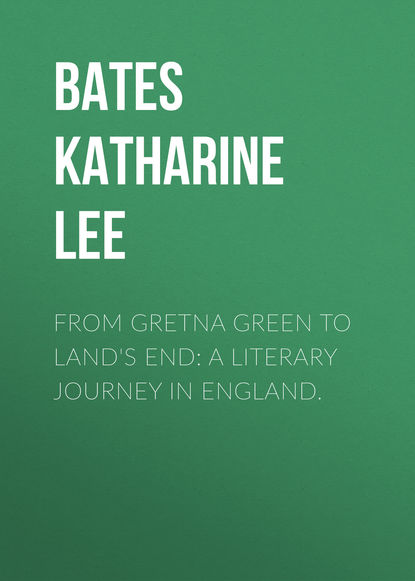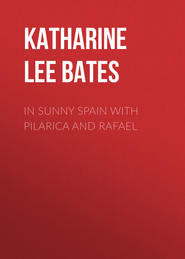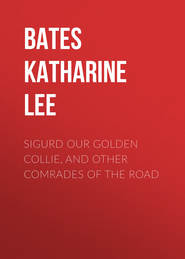По всем вопросам обращайтесь на: info@litportal.ru
(©) 2003-2024.
✖
From Gretna Green to Land's End: A Literary Journey in England.
Настройки чтения
Размер шрифта
Высота строк
Поля
So Buccleuch rode out, one dark night, with a small party of Borderers, and succeeded, aided by one of the gusty storms of the region, in making his way to Carlisle undetected.
"And when we left the Staneshaw-bank,
The wind began full loud to blaw;
But 'twas wind and weet, and fire and sleet,
When we came beneath the castle wa'."
The sudden uproar raised by the little band bewildered the garrison, and to Kinmont Willie, heavily ironed in the inner dungeon and expecting death in the morning, came the voices of friends.
"Wi' coulters, and wi' forehammers,
We garr'd[2 - Made.] the bars bang merrilie,
Until we cam' to the inner prison,
Where Willie o' Kinmont he did lie.
"And when we cam' to the lower prison,
Where Willie o' Kinmont he did lie:
'O sleep ye, wake ye, Kinmont Willie,
Upon the morn that thou's to die?'
"'O I sleep saft, and I wake aft;
It's lang since sleeping was fley'd frae me!
Gie my service back to my wife and bairns,
And a' gude fellows that spier[3 - Inquire.] for me.'"
But his spirits rose to the occasion, and when Red Rowan,
"The starkest man in Teviotdale,"
hoisted Kinmont Willie, whose fetters there was no time to knock off, on his back and carried him up to the breach they had made in the wall, from which they went down by a ladder they had brought with them, the man so narrowly delivered from the noose had his jest ready:
"Then shoulder-high with shout and cry
We bore him down the ladder lang;
At every stride Red Rowan made
I wot the Kinmont's airns[4 - Irons.] play'd clang.
"'O mony a time,' quo' Kinmont Willie,
'I have ridden horse baith wild and wood.[5 - Mad.]
But a rougher beast than Red Rowan
I ween my legs have ne'er bestrode.
"'And mony a time,' quo' Kinmont Willie,
'I've pricked a horse out owre the furse,
But since the day I back'd a steed,
I never wore sic cumbrous spurs.'"
It is high time that we, too, escaped from Carlisle Castle into the open-air delights of the surrounding country. Five miles to the east lies the pleasant village of Wetheral on the Eden. Corby Castle, seat of a branch of the great Howard family, crowns the wooded hill across the river, but we lingered in Wetheral Church for the sake of one who may have been an ancestor of "the fause Sakelde." This stately sleeper is described as Sir Richard Salkeld, "Captain and Keeper of Carlisle," who, at about the time of Henry VII, "in this land was mickle of might." His effigy is sadly battered; both arms are gone, a part of a leg, and the whole body is marred and dinted, with latter-day initials profanely scrawled upon it. But he, lying on the outside, has taken the brunt of abuse and, like a chivalrous lord, protected Dame Jane, his lady, whose alabaster gown still falls in even folds.
We drove eastward ten miles farther, under sun and shower, now by broad meadows where sleek kine, secure at last from cattle-lifters, were tranquilly grazing, now by solemn ranks of Scotch firs and far-reaching parks of smooth-barked, muscular beeches, now through stone-paved hamlets above whose shop-doors we would read the familiar ballad names, Scott, Graham (Graeme), Armstrong, Musgrave, Johnston, Kerr, and wonder how the wild blood of the Border had been tamed to the selling of picture postal cards.
Our goal was Naworth, one of the most romantic of English castles. Its two great towers, as we approached, called imagination back to the days
"When, from beneath the greenwood tree,
Rode forth Lord Howard's chivalry,
And minstrels, as they marched in order,
Played, 'Noble Lord Dacre, he dwells on the Border.'"
Naworth is the heart of a luxuriant valley. The position owes its defensive strength to the gorges cut by the Irthing and two tributaries. These three streams, when supplemented by the old moat, made Naworth an island fortress. The seat of the Earls of Carlisle, it was built by Ranulph Dacre in the fourteenth century. Even the present Lady Carlisle, a pronounced Liberal and a vigorous worker in the causes of Temperance and Woman Suffrage, though claiming to be a more thoroughgoing Republican than any of us in the United States, points out with something akin to pride "the stone man" on the Dacre Tower who has upheld the family escutcheon there for a little matter of five hundred years. In the sixteenth century the Dacre lands passed by marriage to the Howards, and "Belted Will," as Sir Walter Scott dubbed Lord William Howard, proved, under Elizabeth and James, an efficient agent of law and order. Two suits of his plate armour still bear witness to the warrior, whom the people called "Bauld Willie," with the same homely directness that named his wife, in recognition of the ample dower she brought him, "Bessie with the braid apron," but his tastes were scholarly and his disposition devout. Lord William's Tower, with its rugged stone walls, its loopholes and battlements, its steep and narrow winding-stair guarded by a massive iron door, its secret passage to the dungeons, is feudal enough in suggestion, yet here may be seen his library with the oak-panelled roof and the great case of tempting old folios, and here his oratory, with its fine wood-carvings, its Flemish altar-piece, and its deep-windowed recess outlooking on a fair expanse of green earth and silver sky.
This castle, with its magnificent baronial hall, its treasures of art and spirit of frank hospitality, was harder to escape from than Carlisle. There was no time to follow the Irthing eastward to the point where, as the Popping Stones tell, Walter Scott offered his warm heart and honest hand to the dark-eyed daughter of a French emigre. But we could not miss Lanercost, the beautiful ruined abbey lying about a mile to the north of Naworth. An Augustine foundation of the twelfth century, it has its memories of Edward I, who visited it with Queen Eleanor in 1180 and came again in broken health, six years later, to spend quietly in King Edward's Tower the last winter of his life. The nave now makes a noble parish church in which windows by William Morris and Burne-Jones glow like jewels. The choir is roofless, but gracious in its ruin, its pavement greened by moss, feathery grasses waving from its lofty arcades, and its walls weathered to all pensive, tender tints. The ancient tombs, most of them bearing the scallop-shells of the Dacres, are rich in sculpture. Into the transept walls are built some square grey stones of the Roman Wall, and a Roman altar forms a part of the clerestory roof. The crypt, too, contains several Roman altars, dedicated to different gods whose figures, after the lapse of two thousand years, are startling in their spirited grace, their energy of life.
But Lanercost reminds us that we have all but ignored Carlisle Cathedral, and back we drive, by way of the village of Brampton with its curious old market-hall, to the Border City. After all, we have only followed the custom of the place in slighting the cathedral. Carlisle was ever too busy fighting to pay much heed to formal worship.
"For mass or prayer can I rarely tarry,
Save to patter an Ave Mary
When I ride on a Border foray."
The cathedral dates from the time of William Rufus, and still retains two bays of its Norman nave, which suffered from fire in the early part of the thirteenth century. A still more disastrous fire, toward the close of that century, all but destroyed the new choir, which it took the preoccupied citizens one hundred years to rebuild, so that we see to-day Early English arches in combination with Decorated pillars and Late Decorated capitals. These capitals of fresh and piquant designs are an especial feature of the choir, whose prime glory, however, is the great east window with its perfect tracery, although only the upper glass is old. The cathedral has suffered not alone from a series of fires, but from military desecration. Part of its nave was pulled down by the irreverent Roundheads to repair the fortifications, and it was used after Carlisle was retaken from Prince Charlie as a prison for the garrison. Even to-day canny Cumberland shows a grain too much of frugality in pasturing sheep in the cathedral graveyard. Carlisle Cathedral has numbered among its archdeacons Paley of the "Evidences," and among its archdeans Percy of the "Reliques." Among its bridegrooms was Walter Scott, who wedded here his raven-haired lady of the Popping Stones.
One drive more before we seek the Lake Country, – ten miles to the north, this time, across the adventurous Esk, where a fierce wind seemed to carry in it the shout of old slogans and the clash and clang of arms, and across the boundary stream, the Sark, to Gretna Green, where breathless couples used to be married by blacksmith or innkeeper or the first man they met, the furious parents posting after all in vain. Then around by Longtown we drove and back to Carlisle, across the Solway Moss, – reaches of blowing grass in the foreground; dark, broken bogs, where men and women were gathering in the peat, in the middle distance; and beyond, the blue folds of hills on hills. It was already evening, but such was the witchery of the scene, still with something eerie and lawless about it despite an occasional farmhouse with stuffed barns and plump ricks and meadows of unmolested kine, that we would gladly, like the old Borderers whose armorial bearings so frequently included stars and crescents, have spent the night in that Debatable Land, with the moon for our accomplice in moss-trooping.
THE LAKE COUNTRY
There are as many "best ways" of making the tour of this enchanted land as there are Lake Country guidebooks, volumes which, at prices varying from ten shillings to "tuppence," are everywhere in evidence. One may journey by rail to Keswick or to Windermere; one may come up from Furness Abbey to Lakeside, passing gradually from the softer scenery to the wilder; or one may enter by way of Penrith and Pooley Bridge, ushered at once into the presence of some of the noblest mountains and perhaps the loveliest lake.
This last was our route, and very satisfactory we found it. Our stay at Penrith had been abbreviated by a municipal councillors' convention which left not a bed for the stranger. We had been forewarned of the religious convention which throngs Keswick the last full week in July, and, indeed, an evangelist bound thither had presented us with tracts as we took our train at Carlisle. But we had not reckoned on finding Penrith in such plethoric condition, and, after an uphill look at the broken red walls of Penrith Castle, which, with Carlisle, Naworth, and Cockermouth, stood for the defence of western England against the Scots, we mounted a motor-bus, of all atrocities, and were banged and clanged along a few miles of fairly level road which transferred us, as we crossed the Eamont, from Cumberland to Westmoreland. The hamlet of Pooley Bridge lies at the lower end of Ullswater, up whose mountain-hemmed reaches of ever-heightening beauty we were borne by The Raven, a leisurely little steamer with a ruddy captain serenely assured that his lake is the queen of all. The evening was cold and gusty, – rougher weather than any we had encountered in our midsummer voyage across the Atlantic, – but, wrapped in our rugs and shedding hairpins down the wind, we could have sailed on forever, so glorious was that sunset vision of great hills almost bending over the riverlike lake that runs on joyously, as from friend to friend, between the guardian ranks.
We lingered for a few days at the head of Ullswater, in Patterdale, and would gladly have lingered longer, if only to watch the play of light and shadow over St. Sunday Crag, Place Fell, Stybarrow Crag, Fairfield, and all that shouldering brotherhood of giants, but we must needs take advantage of the first clear day for the coach-drive to Ambleside, over the Kirkstone Pass,
"Aspiring Road! that lov'st to hide
Thy daring in a vapoury bourn."
A week at Ambleside, under Wansfell's "visionary majesties of light," went all too swiftly in the eager exploration of Grasmere and Coniston, Hawkshead, Bowness, Windermere, and those "lofty brethren," the Langdale Pikes, with their famous rock-walled cascade, Dungeon Ghyll. The coach-drive from Ambleside to Keswick carried us, at Dunmailraise, across again from Westmoreland to Cumberland. Helvellyn and Thirlmere dominated the way, but Skiddaw and Derwent Water claimed our allegiance on arrival. What is counted the finest coach-drive in the kingdom, however, the twenty-four-mile circuit from Keswick known as the Buttermere Round, remained to bring us under a final subjection to the silver solitude of Buttermere and Crummock Water and the rugged menace of Honister Crag. The train that hurried us from Keswick to Cockermouth passed along the western shore of pleasant Bassenthwaite Water, but from Workington to Furness Abbey meres and tarns, for all their romantic charm, were forgotten, while, the salt wind on our faces, we looked out, over sand and shingle, on the dim grey vast of ocean.
The Lake Country, it is often said, has no history. The tourist need not go from point to point enquiring
"If here a warrior left a spell,
Panting for glory as he fell;
Or here a saint expired."
That irregular circle of the Cumberland Hills, varying from some forty to fifty miles in diameter, a compact mass whose mountain lines shut in narrow valleys, each with its own lake, and radiate out from Helvellyn in something like a starfish formation, bears, for all its wildness, the humanised look of land on which many generations of men have lived and died; but the records of that life are scant.
There are several stone-circles, taken to be the remains of British temples, the "mystic Round of Druid frame," notably Long Meg and her Daughters, near Penrith, and the Druid's Circle, just out of Keswick. About the Keswick circle such uncanny influences still linger that no two persons can number the stones alike, nor will your own second count confirm your first. Storm and flood rage against that mysterious shrine, but the wizard blocks cannot be swept away. The Romans, who had stations near Kendal, Penrith, and Ambleside, have left some striking remembrances, notably "that lone Camp on Hardknott's height," and their proud road, still well defined for at least fifteen miles, along the top of High Street ridge. A storied heap of stones awaits the climber at the top of
"The long ascent of Dunmailraise."
Here, in 945, the last king of the Cumbrian Britons, Dunmail, was defeated by Edmund of England in the pass between Grasmere and Keswick. Seat Sandal and Steel Fell looked down from either side upon his fall. Edmund raised a cairn above what his Saxon wits supposed was a slain king, but Dunmail is only biding his time. His golden crown was hurled into Grisedale Tarn, high up in the range, where the shoulders of Helvellyn, Seat Sandal, and Fairfield touch, and on the last night of every year these dark warders see a troop of Dunmail's men rise from the tarn, where it is their duty to guard the crown, bearing one more stone to throw down upon the cairn. When the pile is high enough to content the king, who counts each year in his deep grave the crash of another falling stone, he will rise and rule again over Cumberland.
Here history and folk-lore blend. Of pure folk-lore the stranger hears but little. Eden Hall, near Penrith, has a goblet filched from the fairies:








